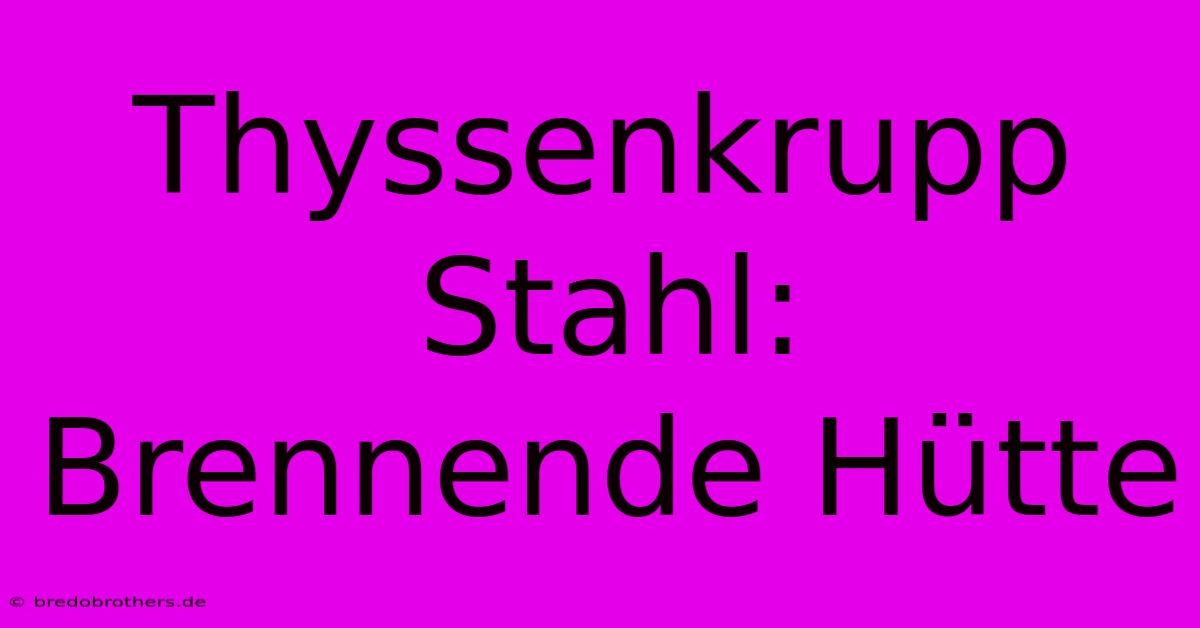Thyssenkrupp Stahl: Brennende Hütte

Discover more detailed and exciting information on our website. Click the link below to start your adventure: Visit Best Website Thyssenkrupp Stahl: Brennende Hütte. Don't miss out!
Table of Contents
ThyssenKrupp Stahl: Brennende Hütte – A Look Back at a Troubled Giant
Hey everyone, so I wanted to chat about ThyssenKrupp Stahl, specifically that whole "brennende Hütte" (burning hut) situation. It was a mess, let me tell you. I remember when it first hit the news – it felt like the whole industry was holding its breath. I was working in steel consulting back then, and it was wild.
The Initial Shock and Aftermath
The whole thing felt surreal, honestly. News reports were flying around – images of fires, talk of massive losses… I mean, ThyssenKrupp? A massive player in the global steel market, practically a household name in Germany. To see them struggling like that… it was a real wake-up call. We all thought, "This can't be happening." It felt like watching a slow-motion train wreck; you know it's coming, but you can't do anything to stop it.
I remember a particularly frantic meeting with one of my clients. We were trying to figure out the ripple effects – how this would impact supply chains, pricing, everything. It was chaos. The uncertainty was the worst part. Everyone was scrambling for information, trying to figure out what the long-term consequences would be. And that's where a lot of my own learning came from, dealing with the fallout from this crisis.
Lessons Learned: Navigating Industry Crises
This whole experience taught me a few crucial things. First, diversification is key. ThyssenKrupp's reliance on certain steel products and markets left them vulnerable. A diversified portfolio can help cushion the blow during tough times. Think about different types of steel, different market segments, even different industries altogether.
Second, strong risk management is paramount. You gotta be on top of your game, constantly anticipating potential problems and developing contingency plans. We should've seen some of the warning signs, and the failure to properly anticipate the downturn and the resulting financial crisis was a key factor in the problems ThyssenKrupp faced. That's something I've stressed with my clients ever since – robust risk assessments and proactive mitigation strategies are non-negotiable.
Third, and this is maybe the most important lesson: transparency and communication are crucial during crises. The more open and honest you are with stakeholders – employees, clients, investors – the better. Covering things up only makes things worse in the long run. It erodes trust, and that's something incredibly difficult to rebuild.
Beyond the "Brennende Hütte": Long-Term Implications
The "brennende Hütte" wasn't just a temporary setback; it had lasting consequences for the entire steel industry. It prompted serious discussions about sustainability, efficiency, and the future of steel production. There was a huge focus on modernizing processes, adopting new technologies, and reducing environmental impact. It pushed the industry to adapt, to innovate, and to become more competitive on a global scale.
Now, I’m no expert on the specific internal workings of ThyssenKrupp's restructuring post-"brennende Hütte," but I do know that the crisis highlighted the need for strong leadership, strategic decision-making, and the ability to adapt quickly in a constantly evolving market. It's a cautionary tale, for sure. But it's also a story about resilience and the potential for transformation. The steel industry is far from dead; it's just… different. And that’s something that we, as professionals, must always keep in mind.
Keywords: ThyssenKrupp Stahl, Brennende Hütte, German steel industry, steel crisis, risk management, diversification, industry restructuring, supply chain disruption, economic downturn, corporate crisis management, crisis communication.

Thank you for visiting our website wich cover about Thyssenkrupp Stahl: Brennende Hütte. We hope the information provided has been useful to you. Feel free to contact us if you have any questions or need further assistance. See you next time and dont miss to bookmark.
Featured Posts
-
Neuverpflichtung Hinteregger Bei Den Violetten
Nov 26, 2024
-
Crash Verletzte Nach Postauto Unfall
Nov 26, 2024
-
Wahlsieg Rumaenien Tik Tok Und Rechtsaussen
Nov 26, 2024
-
Preisverleihung Nestroy Jubilaeumsgala
Nov 26, 2024
-
Thyssenkrupp Stahl Krise Im Stahlwerk
Nov 26, 2024
